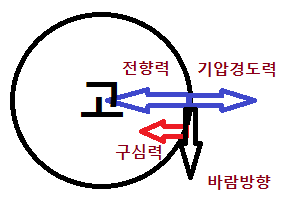지구 세차운동의 방향

세차 운동은 어떤 물체가 회전하고 있을 때, 물체 뿐만 아니라 회전축 자체가 도는 것을 말한다. 예를 들면, 팽이가 회전할 때 축이 기울어져도 바로 넘어지지 않고, 일정시간 기울어진 채로 축 자체가 움직이는 모습을 볼 수 있는데, 이것이 세차운동이다. 아래 그림을 보면 쉽게 이해가 될 것이다. 출처: http://ko.wikipedia.org/wiki/%EC%84%B8%EC%B0%A8_%EC%9A%B4%EB%8F%99 지구 역시 회전, 곧 자전을 하고 있기 때문에 자전축이 세차운동을 하고 있을 것이라고 예상이 가능하며, 이것은 사실이다. 이에, 지구 세차운동의 원인이 무엇이고, 그 방향은 어떻게 결정되는지 알아보자. 지구 세차운동의 원인에는 일월세차(해 달 때문에 생기는 세차) 또는 행성세차(행성 때문에 생기는 세차) 따위가 있는데, 그 중에서 주요한 원인은 일월세차이며, 그 중에서도 해가 핵심 원인이다. 알다시피, 지구는 양 극 사이보다 적도의 길이가 더 긴 타원형이다. 적도 부분이 부풀어 있는 까닭은 지구 자전 때문이다. 그리고 지구 적도면은 공전 궤도면에 대해 23.5 도 기울어져 있다. 바로 이것 때문에 해에 따른 세차 운동이 발생한다. 더 자세히 알아보자. 지구는 지구의 북극 상공에서 내려다 봤을 때, 반시계 방향으로 자전하고 있다. 이 때 돌림힘(토크)의 방향은 지구 북극 방향이 된다. 돌림힘이란 어떤 물체를 회전시키는 힘을 말하며, 이 힘의 방향은 앙페르의 오른손 법칙을 이용하면 쉽게 알 수 있다. 다시 말해서 회전 방향을 손가락으로 가리킨 후 손을 말아쥐고, 엄지를 세웠을 때, 엄지가 가리키는 방향이 돌림힘의 방향이다. 그리고 이 방향은 회전축과 항상 나란하다. 하지만 같다는 뜻은 아니니 조심하자. 지구의 자전 방향대로 손을 말아쥐면 지구 북극 방향과 엄지의 방향이 일치함을 확인할 수 있다. 다음 그림을 보자. 그림에서는 잘 나타나지 않았지만(ㅠㅠ), 지구는 적도 방향이 자전축 방향보다 조금 더 ...


